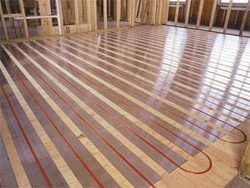Imagine a cold winter morning. It is hard enough to get out of that cozy bed but having to step on the cold floor is worse. However, with the benefits of radiant floor heating you no longer have to face cold floors again but can enjoy the wonderful feeling of walking around barefoot when it is freezing outdoors.
Radiant floor heating entails the installation of tubing water heating or electric type of coils underneath the flooring you plan to install. The tubing is connected to the source, a hot water heater much like the one you may already have! Hot water is passed through the tubing when the system is activated. It turns on when activated by a pre-set thermostat, just like many other methods of heating. When the temperature of the home falls below your comfort level the hot water system is activated and hot water is pumped all through the tubing, silently and out of sight. The heat radiates from the ground upwards through whatever flooring you may have installed above. When compared to conventional systems of forced air systems, radiant floor heating provides a distinct advantage by providing constant heating through the entire room.

Heat usually comes from a definable source. Heat comes from a radiator on the wall, vent, space heater, fireplace, or stove. Typically, in most modern homes, heat comes from the wall or vent, right? Think about that. The heat is coming from the wall or somewhere close to it and rises from there. What about the floor? What about the place where my bare feet walk? What about the place where I step in the winter mornings and immediately realize I’m not wearing socks? The floor!
It makes so much sense that heat should come from the floor, and, if you haven’t experienced radiant heat, it is as wonderful as you imagine.
So now we know that radiant heating is the greatest thing in the world and you want it and you got to have it and if you don’t have it you’ll feel bad and have cold feet forever. We don’t want that.
The most important thing with wood, as you may or may not know, is to keep moisture away from it. Water + Wood= Damage. Therefore you must install the radiant heating on a dry slab or subfloor. Now, the only way to make sure the subfloor is completely dry is to turn the radiant heating system on prior to installation of the hardwood flooring. How long before? Many flooring experts say 36-72 hours is a sufficient amount of time to run the system prior to the wood floor installation.
It does cost a good bit of money to get this heating system installed. The water heater, yards of tubing, and installation all factor in. Read about the costs of this system at www.oldhouseweb.com.
It is not as though the concept behind radiant floor heating systems is a new one. The ancient people of Rome used warm water and hot water pipes to keep their floors warm. Ever since 1970s, European countries have always preferred using this kind of radiant floor heating system for keeping floors warm. In addition to the tremendous cost advantage, radiant floor heating systems help provide silent sources of heat and there are no ducts with loud noises or expensive furnaces. People who have allergies will also benefit from the advantages of radiant floor heating systems. By doing away with blown air methods dust termites can be reduced by as much as 80%. Hence using radiant floor heating can also help combating allergies from such blown air systems.
The radiant floor heating systems are available in two variants namely hydronic and electric. Electric method of radiant floor heating is more expensive compared to hydronic, which explains why more people choose the latter method. If you are renovating an existing house or constructing a new home, hydronic method of radiant floor heating is the best solution. Compared to upfront costs of a furnace, a hydronic radiant floor heating will cost more. However, the benefit is that while furnaces have a shelf life of around 10 or 30 years, your hydronic radiant floor heating will last you more than 40 years! There are also various methods used to get the water heated such as boiler oil-fired, kerosene, solar, gas or gas-fired methods.
"I saved myself hours by using FlooringExpertsUSA.com for my new hardword floor installation. I would have had to research and call multiple hardward floor contractors. Instead, I filled out a quick form and local flooring contractors contacted me with price quotes. "I've never had a home improvement project go so smoothly. "
Thank you! The contractor I choose was a true professional. "
"I used a contractor from your service to sand and refinish my hardware floors and I couldn't happier with the decision I made. The results are tremendous and the floor shines like it is new. This is the best thing I have done for the interior of my home. "